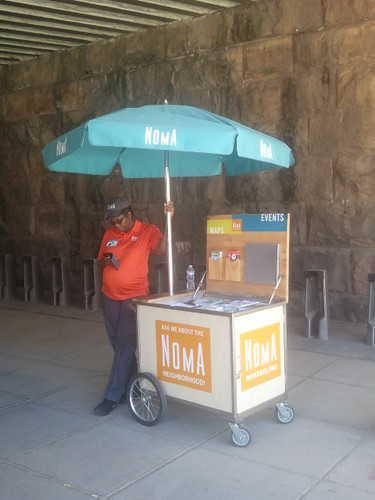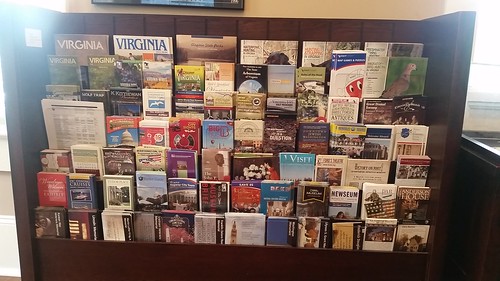Today is World Tourism Day
Each year, the United Nations World Tourism Organization designates World Tourism Day, usually with a specific theme. This year it's "universal accessibility."
My interests are more narrow, more focused on urban tourism as an element of city economies and the need for visitor information coordination across a metropolitan area, especially linking airports, train stations, inter-city bus stations, etc., into a more seamless network.
In "the old days" DC's business community paid more attention to visitor mobility and information services.
I think about it a lot, since DC's "Destination Marketing Organization" isn't focused on supporting and funding what I call "sub-city district marketing" such as for Capitol Hill, Dupont Circle, and Georgetown, three areas of the city with distinct neighborhoods identities and "brands." (Also see the 2012 entry "(DC) Neighborhoods and commercial districts as brands.") Instead they focus on marketing the convention center.
The 2014 World Tourism Day theme was "Tourism and Community Development," and this blog entry discusses that in terms of "city break tourism" and heritage areas.
The 2013 theme was on "Tourism and Water," which I didn't discuss, but instead "urban tourism" and the "visitability concept" developed by Destination Melbourne, as well as the need to do a better job delivering tourism information at the Baltimore-Washington region's airports.
THE FIVE PILLARS OF VISITABILITYIntegrated identity and branding systems. Michigan ("Pure Michigan") and Utah ("Life Elevated") stand out for developing strong branding and extending that identity across tourism and economic development activities at both the local and state scales.
Five key factors were identified as having a significant impact on an outstanding visitor experience and journey. We focus on these pillars to help guide businesses in their delivery and development of positive and valuable visitor experiences.
Sense of Welcome
Sense of Welcome is the first impression a visitor gets of a destination, service or product, including your website. Visitability is about ensuring your visitors feel highly valued, and the connection at each stage is warm, friendly, and – where possible – personalised.
Digital Connectivity
Visitors worldwide increasingly rely on modern technology to plan, book, travel to and share their holiday experiences. Ensuring businesses are visible online, and are using up to date technology, is critical to Melbourne’s relevance and ongoing success as a destination. For example, providing free, reliable WiFi is widely expected by today’s traveller.
Integrated Messaging
Integrated messaging, or the integrated provision of visitor services, aims to ensure that visitors receive consistent messaging and information from all aspects of their visit to provide a seamless experience. This factor is focused on three elements in particular; signage and way finding, printed and online products and key messaging.
Public Transport
The role of Visitability is to advocate for public transport systems to keep visitors' needs top of mind when delivering products and services, ensure that networks are easy and safe to navigate and that route and fare information can be easily found.
Accessibility
As well as providing socially responsible visitor services, an aging population and the importance of inclusiveness provides us with a compelling business case for making Victoria’s visitor industry more accessible and inclusive to all travellers.
VISITABILITY CASE STUDIES. Find out why these businesses and organisations are Melbourne's leaders when it comes to the pillars behind Visitability.
DC has the "We are DC" logo, which is slapped on all the DC Government communications, but it's not a substantive branding mechanism.
 A system of visitor centers within a locality. Arguably, DC doesn't even have a main visitor center, let alone visitor centers across the city. Note that in DC some business improvement districts do provide some of this kind of service, but it tends to be focused on office workers who generally aren't DC residents.
A system of visitor centers within a locality. Arguably, DC doesn't even have a main visitor center, let alone visitor centers across the city. Note that in DC some business improvement districts do provide some of this kind of service, but it tends to be focused on office workers who generally aren't DC residents.There is an information desk in the Convention Center and it is staffed by helpful people. But it only serves the convention segment of the tourism market, which is but one element of the tens of millions of people visiting the city each year. It's not positioned as the city-wide visitor center. (Which I think should be at Union Station.)
By contrast to DC, Miami-Dade County has a very active program in supporting the creation and maintenance of welcome centers across the city and county ("Why Miami-Dade has more visitor centers than any city in the U.S.," Miami Herald). And cities like Montreal and New York City have both main visitor centers as well as welcome centers in high profile neighborhoods such as the Fashion District in Manhattan or Mont Royal-Plateau in Montreal. Every state in the US has a network of visitor centers involving state and local agencies and groups.
From the article:
Due in large part to the Miami area’s cultural diversity, the metro area has more visitor centers than any other in the U.S., said Christine Sarkis, senior editor at travel advice website SmarterTravel. New York City, which also has cultural neighborhoods, only has four. San Francisco has two. Chicago has one.
Kamila E. Pritchett, operations and programing manager for the visitor center in Overtown. Miami Herald photo.Miami supports the visitor center program with a broad marketing campaign under the tagline "It's so Miami." And the ad program supports the city and county generally as well as specific districts, such as shown in the image of the ad for the Overton neighborhood, a traditionally African-American community in the city.
“While one or two central visitor centers is a great idea, it doesn’t necessarily reach visitors where they are, especially in a city like Miami, which isn’t as centralized as a place like New York City,” Sarkis said in an email. “This difference among cities is often just variation in strategy, funding and city layout — but we’re big fans of the neighborhood-based visitor centers approach. It puts useful information (and often great discounts) within reach of more visitors; and each visitor center can set itself up as a place for people who happen to pass by rather than an office that visitors have to make a special trip to reach.”
In Miami-Dade, the model has proved so popular that it has been growing. Through an initiative by the Greater Miami Convention & Visitors Bureau, which partners with local organizations to open the centers, five new welcome centers — including the space in Little Havana — have opened in the past two years alone. Others, such as a full-fledged gift shop and visitor center in Florida City, have been around for decades.
All are tucked under an investment from the tourism bureau to promote Miami’s diverse neighborhoods. ... And for some of the new neighborhoods on the visitor center roster, such as Overtown and Coconut Grove Village West, hosting a center means injecting the community with a sense of organization and purpose. For many of these centers, the purpose is a chance to change perceptions and lure travelers for a wholly local experience.
“Our return is definitely more of a qualitative return,” said Rolando Aedo, chief marketing officer for the bureau. “We are engaging more parts of the community. I’m bringing more customers there, which means I’m bringing economic development. That means other merchants in that immediate area are benefiting more and more from the tourism dollars that flow into this community.”
Supporting visitor centers across the metropolitan area. If you talk to people running visitor centers elsewhere in the region, they tell you (depending on where they are located) that as many as 90% of the people who stop in are interested in DC, yet there isn't a systematic program for providing those centers with a set of DC information and brochures.
DestinationDC doesn't have a delivery system to provide guides and brochures to area visitor centers, instead charging them for shipping--of information that promotes DC(!).

The visitor center in Fairfax City has gone out of their way to develop relationships with DC attractions to put together a set of information marketing DC, which they have organized into one section (pictured above). Also see the 2015 entry, "Area tourism development."
AAA tourism resources for DC. c. 1960.
Developing DC's tourism assets at the neighborhood scale. Many years ago, Kathy Smith of the organization that became CulturalTourism DC (best known for the creation of history trails across the city, and support of annual tour events and an event with embassies) published a book called Capital Assets, which assessed neighborhoods in terms of their readiness to attract visitors from "off the National Mall," as a way to promote cultural heritage tourism and economic development benefits within "Local Washington" as opposed to "the Federal City."
There's a need to revisit and update this study as well as to create a system for implementation which never really happened. Heritage trails aren't enough.
"A Capital Assets Framework for Appraising and Building Capacity for Tourism Development in Aboriginal Protected Area Gateway Communities," Tourism Management, 33: 4 (2012). (while not related to the Kathy Smith work, the framework presented is equally applicable)
National resources. Destination Marketing Association International, the leading internationally-focused trade group, has an initiative called "Destination Next" focused on helping DMOs stay relevant and future focused in developing, managing, and marketing their places.
Labels: community economic development, cultural heritage/tourism, cultural planning, neighborhood planning, tourism planning, travel planning/tourism







1 Comments:
http://www.bostonglobe.com/metro/2017/08/18/travelers-find-massachusetts-doors-locked/2TYRYvsp0N5yBFDIOsgfBJ/story.html
poor visitors centers on I-95 in Massachusetts by comparison to nearby states.
Post a Comment
<< Home